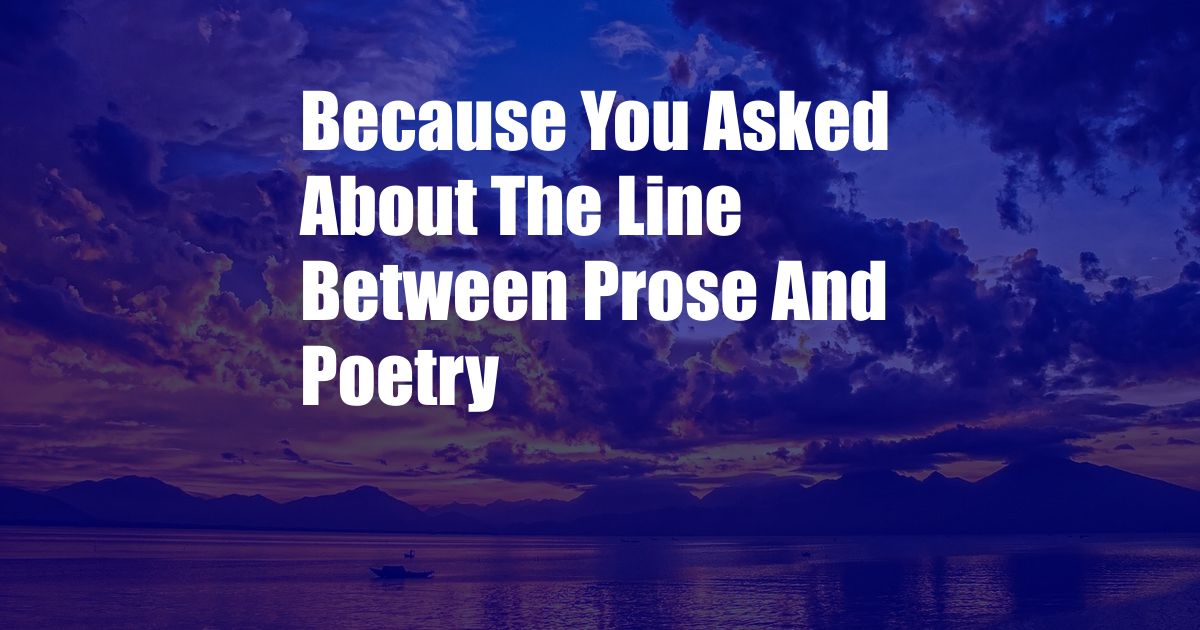
Because You Asked About the Line Between Prose and Poetry
As a blogger, I’ve been asked countless times about the difference between prose and poetry. It’s a question that doesn’t have a straightforward answer. The two forms of writing are often intertwined, and there are many shades of gray in between. But in general, prose is a type of writing that uses everyday language in a straightforward way, while poetry is a type of writing that uses language in a more creative and evocative way.
Prose is typically used for informational or explanatory purposes, while poetry is typically used for expressive or aesthetic purposes. Prose is often written in paragraphs, while poetry is often written in lines. Prose is often written in a simple and direct way, while poetry is often written in a more complex and nuanced way. However, there are many exceptions to these general rules. Some types of prose, such as fiction and creative nonfiction, can be highly poetic, while some types of poetry, such as free verse, can be very close to prose.
The Poetic Line
One of the most distinctive features of poetry is its use of line breaks. While prose is typically written in one continuous stream of words, poetry is often written in lines that are separated by white space. This creates a sense of rhythm and movement that is not present in prose. It can also help to create a sense of tension and anticipation, as the reader waits to see what comes next.
The Rhythm of Poetry
The rhythm of poetry is created by the pattern of stressed and unstressed syllables in each line. Different types of poetry have different rhythmic patterns, but some of the most common include iambic pentameter, dactylic hexameter, and anapestic trimeter. Rhythm can help to create a sense of movement and energy in poetry, and it can also help to emphasize certain words or phrases.
The Meter of Poetry
The meter of poetry is the number of syllables in each line. Different types of poetry have different metrical patterns, but some of the most common include pentameter, hexameter, and trimeter. Meter can help to create a sense of form and structure in poetry, and it can also help to emphasize certain words or phrases.
The Language of Poetry
The language of poetry is often more figurative and imaginative than the language of prose. Poets often use metaphors, similes, and other figures of speech to create vivid images and to convey complex emotions. They also often use words in a way that is unexpected or surprising, in order to create a sense of wonder and delight.
The Imagery of Poetry
Imagery is one of the most important tools that poets use to create vivid and memorable images in the reader’s mind. Poets often use sensory details to appeal to the senses of sight, sound, smell, taste, and touch. They also often use figurative language to create images that are more imaginative and surprising.
The Symbolism of Poetry
Symbolism is another important tool that poets use to convey complex meanings and emotions. Poets often use symbols to represent abstract ideas or concepts, such as love, death, or hope. Symbols can be anything from objects to animals to colors. They can be used to create a sense of mystery and depth in poetry, and they can also help to connect the poem to other works of literature and art.
The Meaning of Poetry
The meaning of poetry is often open to interpretation. There is no one right answer to the question of what a poem means. However, by paying attention to the language, the imagery, and the symbolism of a poem, readers can begin to understand the poet’s intentions and to appreciate the poem on a deeper level.
The Importance of Context
The meaning of a poem can also be affected by its context. This includes the time and place in which it was written, as well as the poet’s personal life and experiences. By understanding the context of a poem, readers can gain a better understanding of its meaning and significance.
Conclusion
The line between prose and poetry is often blurred. However, there are some general characteristics that distinguish the two forms of writing. Prose is typically written in a straightforward way and uses everyday language, while poetry is typically written in a more creative and evocative way and uses language in a more figurative and imaginative way. By understanding the key differences between prose and poetry, readers can better appreciate the unique qualities of each form of writing.
What do you think? Are you interested in learning more about the differences between prose and poetry? Let me know in the comments below.
- Do you have any questions about the difference between prose and poetry?
- What are your favorite examples of prose and poetry?
- Do you have any tips for writing prose or poetry?
FAQ
- Q: What is the difference between prose and poetry?
- A: Prose is a type of writing that uses everyday language in a straightforward way, while poetry is a type of writing that uses language in a more creative and evocative way.
- Q: What are some examples of prose?
- A: Some examples of prose include novels, short stories, essays, and news articles.
- Q: What are some examples of poetry?
- A: Some examples of poetry include sonnets, haikus, and free verse.
- Q: How can I write better prose?
- A: Some tips for writing better prose include using clear and concise language, varying sentence structure, and using vivid imagery.
- Q: How can I write better poetry?
- A: Some tips for writing better poetry include using figurative language, creating interesting rhythms, and paying attention to the sound of your words.